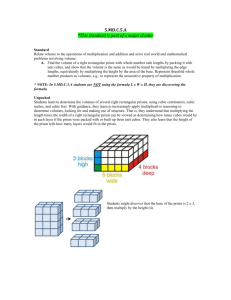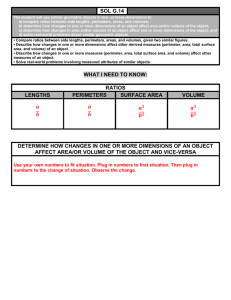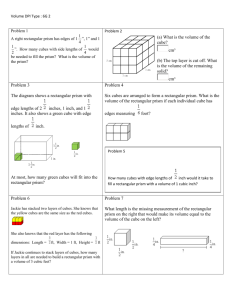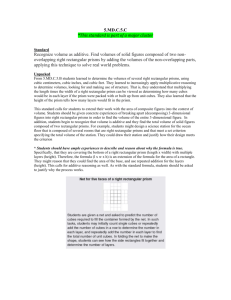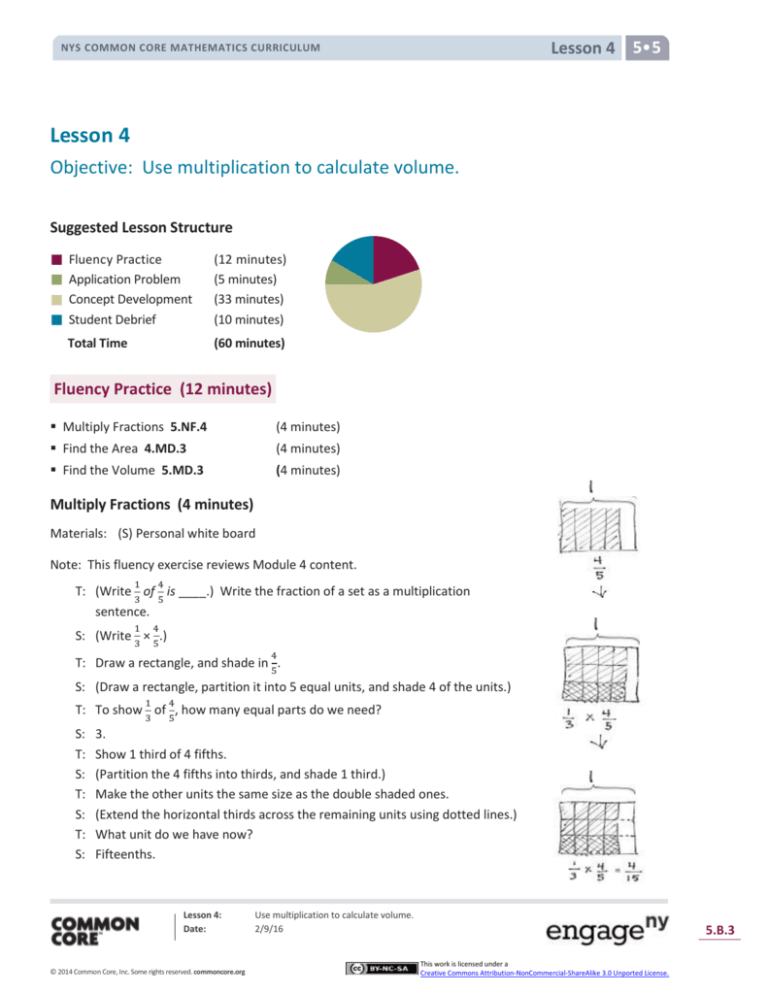
Lesson 4 5•5
NYS COMMON CORE MATHEMATICS CURRICULUM
Lesson 4
Objective: Use multiplication to calculate volume.
Suggested Lesson Structure
Fluency Practice
Application Problem
Concept Development
Student Debrief
Total Time
(12 minutes)
(5 minutes)
(33 minutes)
(10 minutes)
(60 minutes)
Fluency Practice (12 minutes)
Multiply Fractions 5.NF.4
(4 minutes)
Find the Area 4.MD.3
(4 minutes)
Find the Volume 5.MD.3
(4 minutes)
Multiply Fractions (4 minutes)
Materials: (S) Personal white board
Note: This fluency exercise reviews Module 4 content.
1
4
T: (Write of is ____.) Write the fraction of a set as a multiplication
3
5
sentence.
1
4
S: (Write 3 × 5.)
4
T: Draw a rectangle, and shade in 5.
S: (Draw a rectangle, partition it into 5 equal units, and shade 4 of the units.)
1
4
T: To show 3 of 5, how many equal parts do we need?
S:
T:
S:
T:
S:
T:
S:
3.
Show 1 third of 4 fifths.
(Partition the 4 fifths into thirds, and shade 1 third.)
Make the other units the same size as the double shaded ones.
(Extend the horizontal thirds across the remaining units using dotted lines.)
What unit do we have now?
Fifteenths.
Lesson 4:
Date:
© 2014 Common Core, Inc. Some rights reserved. commoncore.org
Use multiplication to calculate volume.
2/9/16
5.B.3
This work is licensed under a
Creative Commons Attribution-NonCommercial-ShareAlike 3.0 Unported License.
Lesson 4 5•5
NYS COMMON CORE MATHEMATICS CURRICULUM
T: How many fifteenths are double shaded?
S: Four.
T: Write the product, and say the sentence.
1
4
4
S: (Write 3 × 5 = 15.)
1
3
4
of 5 is 4 fifteenths.
Continue with the following possible sequence:
2
3
4
×5,
3
5
2
3
5
× 3 , and 5 × 8.
Find the Area (4 minutes)
Materials: (S) Personal white board
Note: Reviewing this Grade 4 concept prepares students to calculate volume.
T:
T:
S:
T:
S:
T:
T:
S:
T:
S:
T:
S:
(Project square with side lengths 10 cm.)
3 ft
How long are the square’s sides?
10 cm.
(Write ____ cm × ____ cm = ____ cm2.) On
20 m
13 ft
your personal white board, write the area of
the square as a multiplication sentence,
including the units.
10 cm
(Write 10 cm × 10 cm = 100 cm2.)
(Project a rectangle labeled 3 ft by 13 ft.)
What is the measure of the rectangle’s
longest side?
4 in
13 ft.
14 in
13 yd
What is the measure of the rectangle’s
shortest side?
20 in
3 ft.
(Write ____ ft × ____ ft = ____ ft2.) Write the area of the rectangle as a multiplication sentence
starting with the length of the longest side.
(Write 13 ft × 3 ft = 39 ft2.)
9 cm
8 yd
Continue this process with the other rectangles and square.
Find the Volume (4 minutes)
Materials: (S) Personal white board
Note: This fluency activity reviews Lessons 1 and 2.
T:
T:
(Project the first image to the right. Number of layers = 2.)
Each cube is 1 cubic centimeter.
(Underneath, write Number of cubes in each layer: ____.)
Fill in the blank.
Lesson 4:
Date:
© 2014 Common Core, Inc. Some rights reserved. commoncore.org
Use multiplication to calculate volume.
2/9/16
5.B.4
This work is licensed under a
Creative Commons Attribution-NonCommercial-ShareAlike 3.0 Unported License.
NYS COMMON CORE MATHEMATICS CURRICULUM
S:
T:
S:
T:
S:
Lesson 4 5•5
(Write Number of cubes in each layer: 6.)
(Write Number of cubes in each layer: 6. Beneath it, write Volume = ____ cubic centimeters + ____
cubic centimeters.) Fill in the blanks.
(Write Volume = 6 cubic centimeters + 6 cubic centimeters.)
(Write Volume = 6 cubic centimeters + 6 cubic centimeters. Beneath it, write Volume = ____ cubic
centimeters.)
(Write Volume = 12 cubic centimeters.)
Continue this process for the remaining prisms.
Application Problem (5 minutes)
Draw a 2 cm × 2 cm × 1 cm rectangular prism on the board, or project an image of one on the board.
Karen says that the volume of this prism is 5 cm3 and that she calculated it by adding the sides together.
Give the correct volume of this prism, and explain Karen’s error.
Note: To find the volume of this figure, Karen could add 2 and 2 (the number of centimeter cubes in each
row), but not by adding all three dimensions.
Concept Development (33 minutes)
Materials: (T) Images of rectangular prisms to project (S) Personal white board, rectangular prism recording
sheet (Lesson 3 Template)
Part 1: Find the volume of multilayer prisms using multiplication.
T:
S:
(Project the leftmost image on the next page.) Record the length, width, and height of this
rectangular prism on your recording sheet. Then, decompose the prism into layers three different
ways to find the volume like we did together yesterday.
(Work on the recording sheet to show the three different decompositions pictured.)
Lesson 4:
Date:
© 2014 Common Core, Inc. Some rights reserved. commoncore.org
Use multiplication to calculate volume.
2/9/16
5.B.5
This work is licensed under a
Creative Commons Attribution-NonCommercial-ShareAlike 3.0 Unported License.
Lesson 4 5•5
NYS COMMON CORE MATHEMATICS CURRICULUM
T:
S:
T:
Let’s record some information about our
prism in this table. Look at this layer on the
top. How many cubes are in each layer?
How do you know?
There are 6 cubes. It is 3 cubes by 2 cubes.
I counted them. It’s like an array,
3 × 2 = 6.
(Record in table as 3 × 2.)
Cubes in Each
Layer
(3 × 2)
(2 × 4)
(3 × 4)
Number of
Layers
4
3
2
Volume
24 cm3
24 cm3
24 cm3
Follow a similar sequence to record the other decompositions.
T:
S:
T:
T:
MP.2
S:
T:
S:
T:
S:
T:
S:
How do we use this information to find the volume of the prism? Turn and talk.
With 4 layers, that’s 4 copies of the same array of cubes, 4 times 6. That’s 24 cubic centimeters.
I see 3 layers that each have 8 cubes in them. Eight cubes 3 times is 24 cubes. That’s 24 cubic
centimeters. Three times 4 shows the cubes in the first layer on the front, but I need 2 of those,
so 2 twelves make 24 cubic centimeters. Count the layers. Four layers, and each layer is a 3 cm
by 2 cm by 1 cm prism, 6 fours is 24. The volume is 24 cubic centimeters.
(Record the number of layers and volumes in the table.)
(Hold up a cube.) We know that this is 1 cubic centimeter. Look at one face of this cube (point to
one face); what is the area of this face?
1 square centimeter.
A = (3 cm × 2 cm)
(Point to the face on the top of the first prism.) If 1
square unit is the area of one cube’s face, and there
are 6 cubes that make up this face, what is the area of
this face? Write a number sentence to show the area.
Be sure to include the units.
3 cm × 2 cm = 6 cm2.
What do you notice about the area of this face and the
number of cubes in this layer?
They are the same.
A moment ago, we said that to find the volume, we had to account for the number of layers in the
prism. How many layers are under this face?
4.
Lesson 4:
Date:
© 2014 Common Core, Inc. Some rights reserved. commoncore.org
Use multiplication to calculate volume.
2/9/16
5.B.6
This work is licensed under a
Creative Commons Attribution-NonCommercial-ShareAlike 3.0 Unported License.
NYS COMMON CORE MATHEMATICS CURRICULUM
MP.2
T:
S:
T:
S:
T:
S:
T:
S:
T:
S:
T:
S:
T:
S:
T:
S:
T:
Lesson 4 5•5
Which dimension of the prism gives us that number?
The height.
How many centimeters is the height? Give me the unit, too.
4 centimeters.
So, we can find the volume by multiplying the area of this face by the height. (Write (3 cm × 2 cm).)
The height, 4 cm, happens to tell us the number of the layers. Show me the multiplication sentence
you can use to find the volume of this prism that matches this way of seeing the layers.
V = (3 cm × 2 cm) × 4 cm = 24 cubic cm. V = 6 cm2 × 4 cm = 24 cm3.
(Write V = (3 cm × 2 cm) × 4 cm = 24 cm3 and 6 cm2 × 4 cm = 24 cm3 on the board.) I notice some of
you wrote 6 cm2 × 4 cm, and others multiplied centimeters by centimeters by centimeters. What
happens to the square units when you multiply them by the third factor? Why? Talk with a partner.
When multiplying a square unit times one more unit, it becomes a cubic unit. You start out with
length units, the second factor makes them square units, and the third factor makes them cubic
units. To measure area, we use squares. To measure volume, we use cubes. The third factor
means we don’t just have flat squares, but cubes.
Is this the same volume we found when we counted by the number of cubes in each layer?
Yes.
A = (4 cm × 2 cm)
Let’s use this method again, but I’d like to use the area
of this face. (Point to the layer on the end.) Write a
multiplication expression that shows how to find the
area of this face.
4 cm × 2 cm.
(Write (4 cm × 2 cm).) To find volume, we need to
know how many layers are to the left of this face.
What dimension of this prism tells us how many layers
this time? How many centimeters is that? Turn and
talk.
This time there are 3 layers. The length is the one that shows how many layers this time. It’s 3
centimeters. The prism is 3 centimeters long. This shows the layers beside this face.
(Write (4 cm × 2 cm) × 3 cm.) Multiply to find the
volume.
A = (3 cm × 4 cm)
(Work to find 24 cm3.)
(Project image of prism shown at right.) Now, let’s
look at this last decomposition. Find the area of the
front face. Tell which dimension shows the layers, and
work with your partner to write an expression to find
the volume. Turn and talk.
Lesson 4:
Date:
© 2014 Common Core, Inc. Some rights reserved. commoncore.org
Use multiplication to calculate volume.
2/9/16
5.B.7
This work is licensed under a
Creative Commons Attribution-NonCommercial-ShareAlike 3.0 Unported License.
Lesson 4 5•5
NYS COMMON CORE MATHEMATICS CURRICULUM
S:
T:
S:
T:
S:
T:
S:
T:
S:
T:
T:
S:
The area of this face is 3 cm times 4 cm. That’s 12 square centimeters. There are 2 layers that are
each 1 cm. 3 × 4 × 2 = 24. The volume is 24 cubic centimeters. The area is 12 square
centimeters, and the width is 2 cm. Twelve square centimeters times 2 centimeters is 24 cubic
centimeters.
This is the same volume as before. Look at all three multiplication sentences. What patterns do you
notice? Turn and talk.
The volume is the same every time. We are multiplying all the sides together, but they are in a
different order. When we multiply the length of the sides together, we get the same volume as
when we counted the layers.
So, does centimeters times centimeters times centimeters give us centimeters cubed? Why or why
not? Turn and talk.
Yes. There are three measurements that are centimeters, and then the answer is in cubic units.
True. There are three factors that have centimeter units. So, the product has to be cubic units
because cubes measure space in three dimensions!
Let’s see if this pattern holds. (Display image of prism shown below.) Record the dimensions of this
prism. What’s different about it?
It’s the same width and length, but now, the height is 1
cm shorter. There are 6 fewer cubic centimeters in
this one. There are still some 2 × 3 layers in this
one.
How would you find its volume? Turn and talk.
I can subtract 6 cubic units from the 24 cubic units in
the 4-layer prism. That makes the volume 18 cubic
centimeters. I can multiply the 6 cubes in the top
layer by 3 layers. That’s 18 cubic centimeters. I can
multiply 2 cm times 2 cm times 3 cm, which is 18 cubic
centimeters. The end has a 6 cm2 area and 3 layers,
so 6 cm2 × 3 cm = 18 cm3. The front face is different
now. It is 3 cm by 3 cm. There is 1 layer behind the 3
cm x 3 cm face for a total of 2 layers.
3 cm × 3 cm × 2 cm = 18 cm3.
Let’s record this. (Record.)
What can we conclude about finding volume from these examples?
We can multiply the sides to find the volume. If we know the area of one face and multiply by
the number of those layers, we can find volume. Yeah, but the number of layers is just the length
of the remaining side.
Part 2: Calculate the volume when the area of one side is given.
T:
S:
(Post the image of 2 cm × 2 cm square illustrated to the right.) This square
shows the top face of a rectangular prism. If the prism is made of 1 cm cubes,
what is the area of this face?
4 square centimeters.
Lesson 4:
Date:
© 2014 Common Core, Inc. Some rights reserved. commoncore.org
Use multiplication to calculate volume.
2/9/16
5.B.8
This work is licensed under a
Creative Commons Attribution-NonCommercial-ShareAlike 3.0 Unported License.
NYS COMMON CORE MATHEMATICS CURRICULUM
T:
S:
T:
S:
T:
S:
T:
T:
S:
T:
S:
T:
S:
T:
S:
T:
S:
Lesson 4 5•5
(Write A = 4 cm2. Then, post the image of prism with a height of 4 cm.)
If the rectangular prism that sits below this face is built of centimeter
cubes and has a height of 4 cm, how many layers of centimeter cubes
are in the prism?
4 layers.
How can we use the layers to find the volume? Turn and talk.
I can see that the length is 2 cm and the width is also 2 cm, so if the
height is 4 cm, I can multiply 2 by 2 by the number of layers, which is 4,
to get the volume. Since the area of the top is 2 cm times 2 cm,
which is 4 cm2, we can just multiply the area of the top by the height to
find the volume.
Show me the multiplication sentence you can use to find the volume of this prism.
V = (2 cm × 2 cm) × 4 cm = 16 cubic cm. V = 4 cm2 × 4 cm = 16 cm3.
(Write V = 16 cm3 on the board.)
(Post the image at right on the board.) What’s different about this
prism?
We can’t see the individual cubes in the face with the area.
We don’t know the dimensions of the top face, just the area.
Do we need the dimensions of that top face to find the volume? Why
or why not?
No, we can use the area. We don’t need to know how many cubes are in each layer. We just
want the total volume. The area of the top and the height are enough to find volume.
Work with a neighbor to find the volume of this prism.
(Work to show V = 6 in2 × 2 in = 12 in3.)
(Post the final image, at right, on the board.) Compare this prism to
the last one. Turn and talk.
This one shows just the area again. This one shows the area of the
front and the width. We can still just multiply them. This time, we
have the area of a different face. We have the area of the front face
and the depth of the prism, which tells how many layers are behind the
front face.
Find the volume of this prism.
(Work to show V = 3 m2 × 3 m = 9 m3.)
Problem Set (10 minutes)
Students should do their personal best to complete the Problem Set within the allotted 10 minutes. For
some classes, it may be appropriate to modify the assignment by specifying which problems they work on
first. Some problems do not specify a method for solving. Students should solve these problems using the
RDW approach used for Application Problems.
Lesson 4:
Date:
© 2014 Common Core, Inc. Some rights reserved. commoncore.org
Use multiplication to calculate volume.
2/9/16
5.B.9
This work is licensed under a
Creative Commons Attribution-NonCommercial-ShareAlike 3.0 Unported License.
NYS COMMON CORE MATHEMATICS CURRICULUM
Lesson 4 5•5
Student Debrief (10 minutes)
Lesson Objective: Use multiplication to calculate volume.
The Student Debrief is intended to invite reflection and
active processing of the total lesson experience.
Invite students to review their solutions for the Problem
Set. They should check work by comparing answers with a
partner before going over answers as a class. Look for
misconceptions or misunderstandings that can be
addressed in the Debrief. Guide students in a
conversation to debrief the Problem Set and process the
lesson.
Any combination of the questions below may be used to
lead the discussion.
Explain how the prisms in Problems 1(d) and 3(b)
are similar and different. Identify the dimensions
of another prism that would have an equivalent
volume to 1(d).
Explain how we get cubic units when we multiply
to find volume.
Connect the term face with the term base.
Discuss with students that these two terms may
be used interchangeably when dealing with right
rectangular prisms. Why could we think of any
face as the base of our prism? Discuss the fact
that if we imagine rotating the prism so that the
chosen face lies at the bottom (what we typically
think of as the base), the remaining dimension can
be thought of as the height of the prism.
In Problem 4, what would happen to the volume
of Tyron’s box if he doubled the height to 16 cm?
If he halved the length? If he doubled the height
while halving the length?
Explain your thought process on Problem 5 as you
found the error in Aaron’s thinking.
Compare your earlier strategies for finding volume
to the method we learned today. How is the
formula for finding the volume of rectangular
prisms helpful?
Lesson 4:
Date:
© 2014 Common Core, Inc. Some rights reserved. commoncore.org
Use multiplication to calculate volume.
2/9/16
5.B.10
This work is licensed under a
Creative Commons Attribution-NonCommercial-ShareAlike 3.0 Unported License.
NYS COMMON CORE MATHEMATICS CURRICULUM
Lesson 4 5•5
Exit Ticket (3 minutes)
After the Student Debrief, instruct students to complete the Exit
Ticket. A review of their work will help with assessing students’
understanding of the concepts that were presented in today’s
lesson and planning more effectively for future lessons. The
questions may be read aloud to the students.
Lesson 4:
Date:
© 2014 Common Core, Inc. Some rights reserved. commoncore.org
NOTES ON
VOCABULARY:
While it is true that any face of a
rectangular prism may serve as the
base, it is not true for other prisms or
cylinders. For example, a right
triangular prism has two triangular
bases, but the remaining rectangular
faces are not bases.
Use multiplication to calculate volume.
2/9/16
5.B.11
This work is licensed under a
Creative Commons Attribution-NonCommercial-ShareAlike 3.0 Unported License.
Lesson 4 Problem Set 5•5
NYS COMMON CORE MATHEMATICS CURRICULUM
Name
Date
1. Each rectangular prism is built from centimeter cubes. State the dimensions, and find the volume.
a.
Length: _______ cm
Width: _______ cm
Height: _______ cm
Volume: _______ cm3
Length: _______ cm
b.
Width: _______ cm
Height: _______ cm
Volume: _______ cm3
Length: _______ cm
c.
Width: _______ cm
Height: _______ cm
Volume: _______ cm3
d.
Length: _______ cm
Width: _______ cm
Height: _______ cm
Volume: _______ cm3
2. Write a multiplication sentence that you could use to calculate the volume for each rectangular prism in
Problem 1. Include the units in your sentences.
a. ______________________________
b. ______________________________
c. ______________________________
d. ______________________________
Lesson 4:
Date:
© 2014 Common Core, Inc. Some rights reserved. commoncore.org
Use multiplication to calculate volume.
2/9/16
5.B.12
This work is licensed under a
Creative Commons Attribution-NonCommercial-ShareAlike 3.0 Unported License.
Lesson 4 Problem Set 5•5
NYS COMMON CORE MATHEMATICS CURRICULUM
3. Calculate the volume of each rectangular prism. Include the units in your number sentences.
a.
b.
4 in
6m
3 in
4 in
3m
V = ____________________________________
2m
V = ____________________________________
4. Tyron is constructing a box in the shape of a rectangular prism to store his baseball cards. It has a length
of 10 centimeters, a width of 7 centimeters, and a height of 8 centimeters. What is the volume of the
box?
5. Aaron says more information is needed to find the volume of the prisms. Explain why Aaron is mistaken,
and calculate the volume of the prisms.
a.
b.
Area = 60 cm2
Area = 20 in2
12 in
5 cm
Lesson 4:
Date:
© 2014 Common Core, Inc. Some rights reserved. commoncore.org
Use multiplication to calculate volume.
2/9/16
5.B.13
This work is licensed under a
Creative Commons Attribution-NonCommercial-ShareAlike 3.0 Unported License.
Lesson 4 Exit Ticket 5•5
NYS COMMON CORE MATHEMATICS CURRICULUM
Name
Date
Calculate the volume of each prism.
a.
Length: _______ mm
Width: _______ mm
Height: _______ mm
Volume: ____________ mm3
Write the multiplication sentence that shows how you calculated the volume. Be sure to include the
units.
b. A rectangular prism has a top face with an area of 20 ft2 and a height of 5 ft. What is the volume of
this rectangular prism?
Lesson 4:
Date:
© 2014 Common Core, Inc. Some rights reserved. commoncore.org
Use multiplication to calculate volume.
2/9/16
5.B.14
This work is licensed under a
Creative Commons Attribution-NonCommercial-ShareAlike 3.0 Unported License.
Lesson 4 Homework 5•5
NYS COMMON CORE MATHEMATICS CURRICULUM
Name
Date
1. Each rectangular prism is built from centimeter cubes. State the dimensions and find the volume.
Length: _______ cm
a.
Width: _______ cm
Height: _______ cm
Volume: _______ cm3
b.
Length: _______ cm
Width: _______ cm
Height: _______ cm
Volume: _______ cm3
c.
Length: _______ cm
Width: _______ cm
Height: _______ cm
Volume: _______ cm3
d.
Length: _______ cm
Width: _______ cm
Height: _______ cm
Volume: _______ cm3
2. Write a multiplication sentence that you could use to calculate the volume for each rectangular prism in
Problem 1. Include the units in your sentences.
a. ______________________________
b. ______________________________
c. ______________________________
d. ______________________________
Lesson 4:
Date:
© 2014 Common Core, Inc. Some rights reserved. commoncore.org
Use multiplication to calculate volume.
2/9/16
5.B.15
This work is licensed under a
Creative Commons Attribution-NonCommercial-ShareAlike 3.0 Unported License.
Lesson 4 Homework 5•5
NYS COMMON CORE MATHEMATICS CURRICULUM
3. Calculate the volume of each rectangular prism. Include the units in your number sentences.
a.
b.
10 m
8 in
7m
3m
4 in
8 in
Volume: ________________________________
Volume: ________________________________
4. Mrs. Johnson is constructing a box in the shape of a rectangular prism to store clothes for the summer. It
has a length of 28 inches, a width of 24 inches, and a height of 30 inches. What is the volume of the box?
5. Calculate the volume of each rectangular prism using the information that is provided.
a. Face area: 56 square meters
Height: 4 meters
b. Face area: 169 square inches
Height: 14 inches
Lesson 4:
Date:
© 2014 Common Core, Inc. Some rights reserved. commoncore.org
Use multiplication to calculate volume.
2/9/16
5.B.16
This work is licensed under a
Creative Commons Attribution-NonCommercial-ShareAlike 3.0 Unported License.

